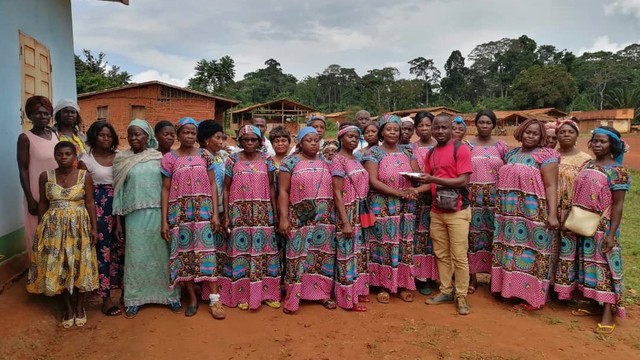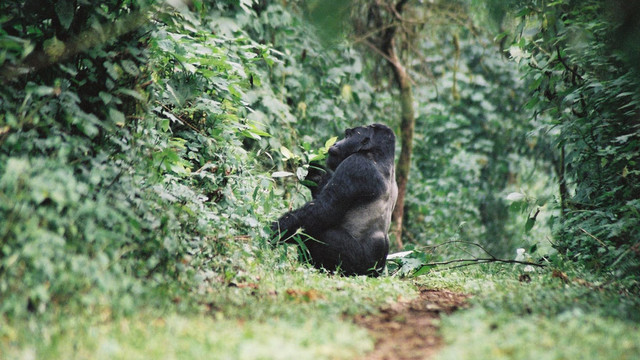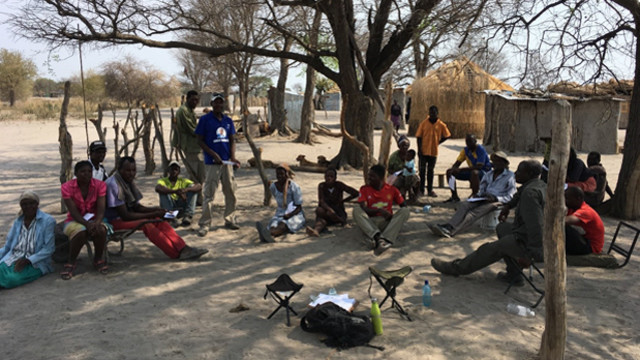TV documentary highlights conservation and poverty links in Cameroon
Making a TV documentary about great ape conservation allowed the PCLG project in Cameroon to focus attention on the impacts on local communities.

A stray ape rescued by Limbe Wildlife Centre in South West Cameroon (Photo: Stanley Dinsi)
A Poverty and Conservation Learning Group (PCLG) project in Cameroon has brought in the TV cameras to raise awareness about great ape conservation and poverty alleviation. IIED talked to Dr Stanley Dinsi, the project's programme officer, to find out more.
Why did PCLG Cameroon decide to make a documentary?
We wanted to raise awareness about the challenges faced by local communities living around protected areas, such as the Campo National Park and the Limbe Wildlife centre in Cameroon.
What is the documentary about?
The documentary presents key findings from a study we carried out looking at the impact of private investments in the Campo Ma'an National Park in South Cameroon and the Limbe Wildlife Centre in South West Cameroon on great ape conservation and local livelihoods.
We wanted to share the results of this research findings with wider audiences – with government, the private sector, conservation organisations, donor organisations and local communities.
How did you go about making the documentary?
The documentary, which was funded by the Arcus Foundation, was one part of our wider communication project to raise awareness around great ape conservation and poverty reduction. Before we began filming, we did outreach in the local communities in Campo and Limbe through workshops and we commissioned radio programmes. These were broadcast in English, French, Pidgin English and local languages.
For the filming, we made four field trips, two in Campo and two in Limbe, to interview the people involved in conservation on the ground and members of the local communities.
 We talked to conservation workers, traditional rulers (chiefs), farmers, administrative officials, eco-guards, researchers, media practitioners, villagers and civil society representatives about their experiences and the challenges they experience in relation to conservation and its impacts on local livelihoods.
We talked to conservation workers, traditional rulers (chiefs), farmers, administrative officials, eco-guards, researchers, media practitioners, villagers and civil society representatives about their experiences and the challenges they experience in relation to conservation and its impacts on local livelihoods.
It was quite demanding. We wanted to film the gorillas in the Campo National Park. But the animals could only be seen very early in the morning, when they set out to find food, and late in the evening, when they return from the heart of the forest. We also had to track deep into the park in the rainy season, which was difficult.
Did you face other challenges?
Access to the park was difficult because the roads are rough. And it wasn't easy convincing Bagyeli local guards in the Campo Park to be interviewed. They are pygmy people who help out with surveillance alongside state eco-guards. And some of the local Bantu populations were hostile to the team. Many of them are frustrated by the conservation efforts and feel that more attention is being paid to animals than to the humans.
What was the best thing about making the documentary?
We managed to convince the Bagyeli guards in the forest to grant us interviews, and eventually the local Bantu populations realised that by providing us with information, we could raise awareness of their problems with local and national level authorities.
It was also really exciting to film gorillas, chimps and other animals in the Limbe Wildlife Centre. And seeing the final product was great. A real satisfaction.
Has the documentary been a success?
It is too early to tell. For the moment, it is also available on the PCLG website (and below). It will also be shown on the national television station, CRTV, so we hope that it will reach a really wide audience.
We think the documentary will be very useful for raising awareness on conservation and livelihoods matters. People have the opportunity to see real pictures and listen to touching experiences from the field.
The main messages that we hope will be conveyed by the documentary are: communities around conservation sites do not receive enough benefits from protected areas; often problems related to wildlife crime arise because the buffer zones between communities and the parks are not respected; and local communities need more alternative revenue sources to be able to sustain their livelihoods.
Dr Stanley Chung Dinsi (dinsistanley@yahoo.fr) is programme officer for the Network for Environment and Sustainable Development in Central Africa (NESDA-CA), which convenes PCLG Cameroon. He is also a lecturer in the Faculty of Laws and Political Science at the University of Yaoundé II-Soa.
- For more information, see the PCLG Cameroon website.



